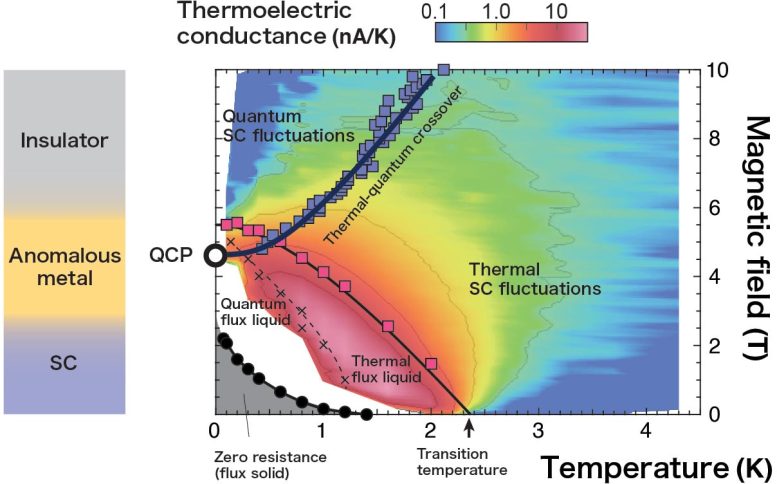Quantum Breakthrough Reveals Superconductor’s Hidden Nature
[ad_1]

Researchers at Tokyo Tech identify the quantum critical point in superconductors, solving a three-decade-old mystery and enhancing the understanding of superconductivity fluctuations. Credit: SciTechDaily.com
Thermoelectric effect reveals full picture of fluctuations in superconductivity.
Weak fluctuations in superconductivity,[1] a precursor phenomenon to superconductivity, have been successfully detected by a research group at Tokyo Institute of Technology (Tokyo Tech). This breakthrough was achieved by measuring the thermoelectric effect[2] in superconductors over a wide range of magnetic fields and over a wide range of temperatures from much higher than the superconducting transition temperature to very low temperatures near 
Figure 1. (Left) In a magnetic field of moderate magnitude, magnetic flux lines penetrate in the form of defects accompanied by vortices of superconducting currents. (Center) Conceptual diagram of the “superconducting fluctuation” state, a precursor to superconductivity. Time-varying, spatially non-uniform, bubble-like superconducting regions are formed. (Right) Schematic diagram of thermoelectric effect measurement. Magnetic flux line motion and superconducting fluctuations generate a voltage perpendicular to the heat flow (temperature gradient). Credit: Koichiro Ienaga
However, it has been known since the 1990s that for samples with relatively weak localization effects, an anomalous metallic state appears in the intermediate magnetic field region where the electrical resistance is several orders of magnitude lower than the normal state. The origin of this anomalous metallic state is thought to be a liquid-like state in which magnetic flux lines (Fig. 1 left) that penetrate into the superconductor move around due to quantum fluctuations.
However, this prediction has not been substantiated because most previous experiments on two-dimensional superconductors have used electrical resistivity measurements that examine the voltage response to current, making it difficult to distinguish between voltage signals originating from the motion of magnetic flux lines and those originating from the scattering of normal-conducting electrons.
A research team led by Assistant Professor Koichiro Ienaga and Professor Satoshi Okuma of the Department of Physics, School of Science at Tokyo Tech reported in Physical Review Letters in 2020 that quantum motion of magnetic flux lines occurs in an anomalous metallic state by using the thermoelectric effect, in which voltage is generated with respect to heat flow (temperature gradient) rather than current.
However, to further clarify the origin of the anomalous metallic state, it is necessary to elucidate the mechanism by which the superconducting state is destroyed by quantum fluctuation and transitions to the normal (insulating) state. In this study, they performed measurements aimed at detecting the superconducting fluctuation state (center of Fig. 1), which is a precursor state of superconductivity and is thought to exist in the normal state.

Figure 2. The full picture of fluctuations in superconductivity has been revealed over a wide magnetic field range and over a wide temperature range, from much higher than the superconducting transition temperature to very low temperature of 0.1 K. The existence of a crossover line between thermal (classical) and quantum fluctuations is demonstrated for the first time, and the quantum critical point where this line reaches absolute zero is found to exist inside the anomalous metallic region. Credit: Koichiro Ienaga
Research Achievements and Techniques
In this study, a molybdenum-germanium (MoxGe1-x) thin films with an amorphous structure,[5] known as a two-dimensional superconductor with uniform structure and disorder, was fabricated and used. It is 10 nanometers thick (one nanometer is one billionth of a meter) and promises to have the fluctuation effects characteristic of two-dimensional systems.
Since fluctuation signals cannot be detected by electrical resistivity measurements because they are buried in the signal of normal-conducting electron scattering, we performed thermoelectric effect measurements, which can detect two types of fluctuations: (1) superconducting fluctuations (fluctuations in the amplitude of superconductivity) and (2) magnetic flux line motion (fluctuations in the phase of superconductivity).
When a temperature difference is applied in the longitudinal direction of the sample,the superconducting fluctuations and the motion of the magnetic flux lines generate a voltage in the transverse direction. In contrast, normal electron motion generates voltage primarily in the longitudinal direction. Especially in samples such as amorphous materials, where electrons do not move easily, the voltage generated by electrons in the transverse direction is negligible, so the fluctuation contribution alone can be selectively detected by measuring the transverse voltage (Fig. 1, right).
The thermoelectric effect was measured in a variety of magnetic fields and in a variety of temperatures ranging from much higher than the superconducting transition temperature of 2.4 K (Kelvin) to very low temperature of 0.1 K (1/3000 of 300 K, the room temperature), which is close to absolute zero. That reveals that superconducting fluctuations survive not only in the liquid region of the magnetic flux (dark red region in Fig. 2), where superconducting phase fluctuations are more pronounced, but also over a wide temperature-magnetic field region farther outwards that is considered to be the normal-state region, where superconductivity is destroyed (the high-temperature and high-magnetic field region above the upper convex solid line in Fig. 2). Notably, the crossover line between thermal (classical) and quantum fluctuations was successfully detected for the first time (thick solid line in Fig. 2).
The value of the magnetic field when the crossover line reaches absolute zero likely corresponds to the quantum critical point where quantum fluctuations are strongest, and that point (white circle in Fig. 2) is clearly located inside the magnetic field range where an anomalous metallic state was observed in the electrical resistance. It was not possible to detect the existence of this quantum critical point from electrical resistivity measurements until now.
This result reveals that the anomalous metallic state in a magnetic field at absolute zero in two-dimensional superconductors, which has remained unresolved for 30 years, originates from the existence of the quantum critical point. In other words, the anomalous metallic state is a broadened quantum critical ground state for the superconductor-insulator transition.
Implications
The thermoelectric effect measurements obtained for amorphous conventional superconductors can be regarded as standard data for the thermoelectric effect on superconductors, since they capture purely the effect of fluctuations in superconductivity without the contribution of normal-state electrons. The thermoelectric effect is important in terms of its application to electric cooling systems, etc., and there is a need to develop materials that exhibit a large thermoelectric effect at low temperatures to extend the limit of cooling temperatures. Anomalously large thermoelectric effects have been reported at low temperatures in certain superconductors, and comparison with the present data may provide a clue to their origin.
Future Development
Of academic interest that will be developed in this study is demonstrating the theoretical prediction that in two-dimensional superconductors with stronger localization effects than the present sample, the magnetic flux lines will be in a quantum condensed state6. Moving forward, we plan to deploy experiments using the methods of this study with the aim of detecting them.
The results of this study were published online in DOI: 10.1038/s41467-024-46628-7
[ad_2]
Read More:Quantum Breakthrough Reveals Superconductor’s Hidden Nature

Comments are closed.